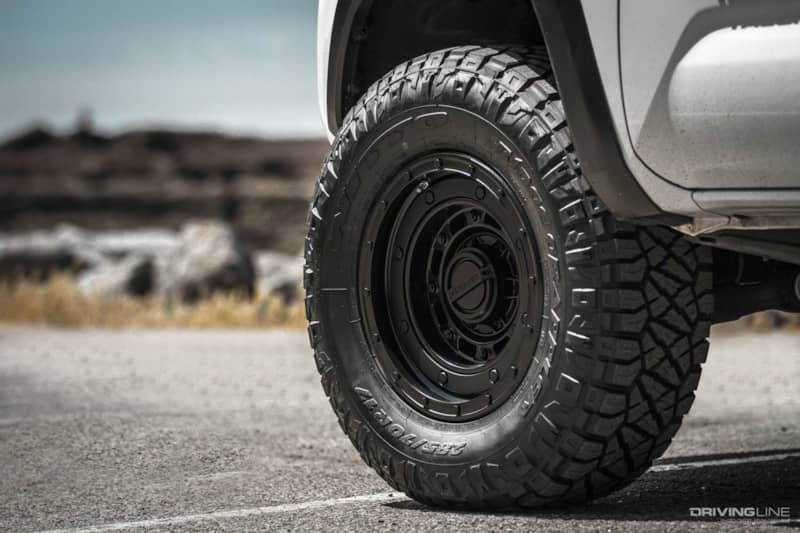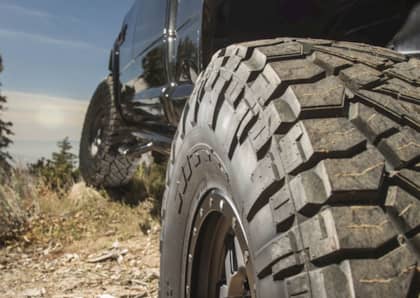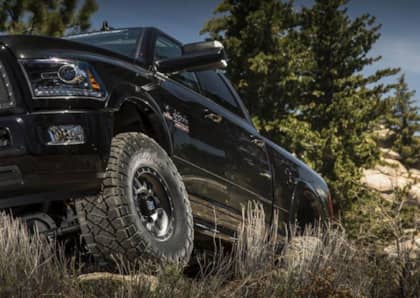How to Maximize the Lifespan of Your Off-Road Tires
Tires, just like many other vital components to any automobile, are considered wear and tear items. While some will undoubtedly last longer than others, all tires will eventually need to be replaced. Most motorists are aware of the different maintenance methods for ensuring they get the most life from their tires. But, do the same rules apply to off-road vehicles rolling on a set of off-road tires? Off-road vehicles are designed to travel over much more treacherous terrain than passenger cars, and therefore, many aspects of off-road tires are different, including the methods of maintaining them. In this article, we will take a deep-dive into six important steps to get the most from your off-road tires.

1. Selecting the Right Tire
Our first step takes place before the tires are even installed on your rig. Whether you have a 1-ton pickup truck for towing, a fully built Jeep on 40-inch mud-terrains, or a daily-driven pickup truck on all-terrain tires that occasionally sees off-road use, selecting the right tires for your vehicle is the first step to making sure you get the most life out of them. All vehicles come from the manufacturer with a sticker (usually on the driver’s door jamb area) that specifies the gross vehicle weight rating and recommended tire size and inflation pressure, as specified by the manufacturer. While most passenger car owners can safely use this recommendation to find the right tires when it comes to replacing them, owners of vehicles that are modified for off-road use typically cannot. Modifying a vehicle for off-road use typically means adding suspension lift, utilizing over-sized tires, and adding a significant amount of weight to the vehicle.

In addition to different sizes and tread patterns, all tires have a measurement called “load ranges.” This load range rating is typically seen as a letter, such as load range C or load range D, and is printed on the sidewall of the tire. The different load range ratings specify the comparative toughness of the tire, based on how much weight it can carry, its sidewall composition, and the maximum air pressure it can hold. Selecting the correct load range for your vehicle is imperative to its longevity. Installing a tire that is engineered for a lighter vehicle on a heavy truck that tows a trailer not only severely reduces its life-span, but it can be dangerous.

However, not all load range ratings are the same across all manufacturers. For this reason, we must look for another number, called the “load index” number, located on the tire’s sidewall. Most tire manufacturers will also list the load index in the specifications of their tires online and in printed catalogs. The load index number is the most accurate way of knowing what the exact maximum weight the tire can carry, at its maximum inflation pressure. Multiplying this maximum weight number by four will tell you the maximum weight all four tires can hold. Compare this number to the weight of your rig when it’s fully weighed down with gear or a trailer. The load carrying capacity of the tires should be significantly higher than the weight of the vehicle. Use the chart in this link to identify your load index and calculate the maximum weight-carrying capacity of your tires.

In addition to the right specifications, selecting the right kind of tire will significantly increase their longevity on your off-road rig. Nitto Tire offers several types of tires designed for different off-road uses, as part of their Grappler line of tires. All-terrain tires, such as the Terra Grappler G2, are designed for vehicles that see light off-road use. If you do mostly highway driving, but find yourself adventuring off the pavement once in a while, all-terrains are a good choice. Mud-terrain tires, such as the Trail Grappler and Mud Grappler, offer the highest level of off-road traction, and are the best choice for off-road vehicles that see heavy trail use. If you have a dedicated crawling rig, or a truck that is mostly used in the dirt and mud, these tires are best suited for you. Hybrid-terrain tires, such as the Ridge Grappler, blend the best of both worlds into one tire. If you do equal parts highway driving and off-road driving, such as a daily driven truck that’s also a weekend warrior, hybrid-terrain tires will offer you the most grip when on the trails, while maintaining the best road manners with a smooth, quiet ride. Not only will you see the best performance by picking the right type of tires for your rig, but you can maximize their longevity by using them as designed.

2. Airing Down
Most people know to keep the right amount of air in their tires. Not only is it an important safety measure when driving any vehicle, but it has significant effects on fuel economy, performance and tire longevity. But contrary to passenger vehicles, off-road driven vehicles will often fare better with reduced air pressure while on the trails. This is due to several factors in the physical changes in a tire with lowered air pressure.

When you reduce the air pressure in a tire, you increase the traction patch of the tire, or the size of the “footprint” it leaves on the ground. A bigger footprint means more traction, which can help get up and over obstacles such as rocks and steep inclines easier. But how does lowering the air pressure in your tires when you’re off-road aid in the tires overall longevity?

While driving off road, your tires are more susceptible to slipping across the terrain. Whether its loose gravel, sand, rocks, dirt, snow or mud, the elements below your tires are constantly sliding under them, wearing away the tread little by little. Reducing the tire pressure reduces that slip due to the increase in traction, and therefore reduces the rate of wear on the tire’s tread.

Reducing your tire pressure can also increase its lifespan by making the tire more moldable to the surfaces it rolls over. While accelerating through rough terrain, such as jagged rocks or gravel, tires at full pressure are more likely to “chunk” or lose bits of their tread because the tire is forced to keep its round shape. But reducing the tire pressure allows the tread to mold to the surface, absorbing the rough edges of the terrain below it rather than fighting against it. Over time, this will significantly help tread blocks remain intact, and increase the lifespan of the tire.

3. Rotating in Your Spare
We all know about rotating our tires regularly. How often you do it depends on how you drive your car and how many miles you put on it. Most vehicles have different drivetrains; some power the front wheels, others the rear, and some can do both all the time, or part of the time. Most vehicles have different amounts of weight over the front and rear axles, which leads to uneven wear between the front and rear tires. These are the essential reasons why rotating your tires on any vehicle is imperative to their longevity, including your off-road rig. But what if you have a full-size spare tire on your 4x4? You’ll want to rotate all your tires so you don’t end up with four completely worn tires and a single brand new one. Here we will explain the proper technique for rotating in your full-size spare tire to get even wear across all five tires throughout their lifespan.

Most off-road vehicles have either a full-time or part-time four-wheel drive drivetrain that requires the same size tires on every corner. Normally, these tires are non-directional, meaning they are engineered to rotate in either direction. This allows you to swap sides as well as axles when rotating your tires, also called the “cross-rotation” method. But swapping in a full-size spare tire changes the cross-rotation method quite a bit. Take a look at the following illustration.

As you can see, it’s a bit more complicated than simply cross-rotating the tires. When rotating in your fifth tire, you’ll want to move the spare to the passenger side rear, and move that tire to the passenger front. Move the Passenger side front to the Driver's side rear. Move your driver’s side rear the driver’s side front, and move that driver’s side front to the spare tire location. This is known as the “clockwise five-tire rotation,” and is recommended by auto manufacturers that provide a full-size spare tire with their vehicles, such as the Jeep Wrangler. This method ensures that the tires rotate in a clockwise manner, and each tire will be designated as the spare tire at some point throughout its life.

4. Check Your Shocks
One aspect of tire longevity that is often overlooked is ensuring the vehicle’s suspension is in proper order. One of the fastest ways an off-road tire can “go bad” or become unusable before its tread is fully worn down is by way of “cupping.” A cupped tire has peaks and valleys along the tread, and can be felt by running your hand across the tread in the direction of rotation. This phenomenon is most often caused by faulty shocks, and can happen to any vehicle. Since off-road SUVs and trucks see much more suspension abuse, there is a higher likelihood of the shocks needing replacement, therefore leading to cupped tires. But what’s the correlation between a faulty shock absorber and a cupped tire?

Your shock absorbers do much more than provide a smooth ride for you and your passengers. They also absorb the “shock” that your tires are subject to when going down the road. If your shocks are no longer doing their job of controlling the impacts from uneven road surfaces, then they are passing along the impacts to your springs. It doesn’t matter whether you have coil springs, leaf springs, coilovers, or torsion bars on your vehicle; if your shocks aren’t working, the springs are taking the force of impact.
But unlike shocks, springs produce an equal but opposite reaction. When you go down a bumpy road with bad shocks, your springs are constantly compressing and expanding, creating a bouncing effect on your axles, wheels and tires. Since the only part of the drivetrain that actually contacts the road surface is the tires, this bouncing motion as the tire rotates creates uneven wear along the tread in path of rotation, and over time, creates the peaks and valleys on the tread known as cupping. Cupped tires will produce a bumpy, unpleasant ride, and can be dangerous if not replaced. So, the moral of the story is: make sure your shocks are still working correctly if you want your tires to last.

5. Correct Alignment
Equally as important as checking your shocks is ensuring your vehicle’s alignment is correct. In almost any application, installing a suspension lift on a vehicle requires a wheel alignment to be performed before the vehicle is deemed road-worthy. Depending on the type of suspension you have, lifting a truck or SUV will change the alignment of the front wheels, which can affect how evenly the tread wears over time. Evenly worn tires will last much longer, and increase the time between buying new tires.

Furthermore, not all alignments are the same. If you install a suspension lift with larger tires and different offset wheels on your vehicle, there’s a strong possibility that the factory alignment specifications will no longer apply. Factory alignment specs only apply to factory suspension, wheel and tire dimensions. A good alignment technician will know how to properly align your lifted truck or SUV, so make sure you do your research before choosing an alignment shop.

6. Proper Storage
The last step on our list applies to anyone who only occasionally uses their rig. If you have a dedicated off-road vehicle that sits in the driveway or the yard between wheeling trips, or you have a long-term project that won’t be running for more than a few months, proper tire storage will help extend the life of your tires.

Like most rubber compounds, tires are susceptible to oxidation, which manifests as dry-rotting. All tires will eventually oxidize and become hard and dry, which leads to cracks in the rubber that make them unsafe for road use. This process is sped up significantly by letting them sit out in the sun and heat. Storing loose tires inside a shed or the garage will slow this process. If your tires are mounted on the vehicle, and there’s no option to park inside, you may want to invest in some tire covers (like those found on RVs in storage) between your trips. When you’re ready to hit the trails, simply pull the covers off and go.

And that’s about it! Hopefully this guide helps you get the most from your off-road tires, whether you’re using them for a few trips per year or every single day. When it comes time to replacing your off-road tires, check out Nitto’s line of Grappler tires, where you’ll find the right tire for your rig, no matter what you do with it.
Click here to find out how to properly maintain beadlock wheels.











